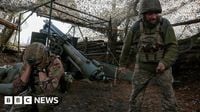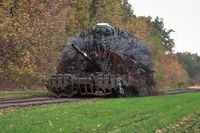On October 31, 2025, Ukrainian President Volodymyr Zelenskyy stood before reporters in Kyiv and delivered a sobering assessment: Russia has deployed about 170,000 troops in Ukraine’s eastern Donetsk region, intensifying their campaign to seize the strategic city of Pokrovsk. The city, battered by over a year of fierce fighting, now finds itself at the center of one of the war’s most pivotal battles. Zelenskyy described the situation as “difficult,” but pushed back against Russian claims that Pokrovsk is fully surrounded.
“There are Russians in Pokrovsk,” Zelenskyy said, as reported by the Associated Press. “They are being destroyed, gradually destroyed, because, well, we need to preserve our personnel.” He acknowledged that some Russian units had infiltrated parts of the city, but insisted Ukrainian defenders were actively “weeding them out.” The president’s remarks underscored both the gravity of the situation and Ukraine’s determination not to cede the city without a fight.
Pokrovsk’s fate has become a symbol of the broader struggle in eastern Ukraine. Russian President Vladimir Putin has made no secret of his ambition to capture the city, touting what he calls “significant advances” on the battlefield. But, as AP and other outlets have noted, these gains have come at a steep cost in manpower and armor. Ukrainian officials have pointed out that Russian progress has been slow and costly, with both sides suffering heavy losses.
Putin, meanwhile, has been working to convince the United States and Western allies that Ukraine cannot sustain its defense against Russia’s larger army. He has repeatedly highlighted Moscow’s nuclear capabilities, using them as a rhetorical shield while refusing to compromise on what he terms Russia’s “legitimate war aims.” According to AP, Putin’s messaging is aimed at persuading the U.S. to accept a peace deal on his terms, arguing that Ukraine’s resistance is ultimately futile in the face of Russian military superiority.
Yet Ukraine has not been passive. In a series of bold moves, Ukrainian forces have intensified their long-range strikes on Russian oil infrastructure. Since the beginning of 2025, Ukraine has conducted more than 160 successful attacks on Russian oil extraction and refining facilities, according to Vasyl Maliuk, the head of Ukraine’s Security Service. “Clearly, we are not resting on our achievements,” Maliuk said at a recent briefing. “There are many fresh perspectives and new approaches in this work. These include new equipment, new combat units, and new methods and means of communication.”
The strikes, Maliuk claimed, have had a tangible impact: a 20 percent drop in oil products on Russia’s domestic market and the temporary halt of 37 percent of the country’s oil refining capacity. These assertions, while difficult to independently verify, suggest that Ukraine is seeking to disrupt Russian military logistics and bring the realities of war closer to Russian civilians. In September and October alone, 20 such strikes were carried out, Maliuk reported.
Ukraine’s attacks have not been limited to oil facilities. Maliuk also revealed that Ukrainian forces have destroyed nearly half of Russia’s sophisticated Pantsir air defense systems this year—systems that had previously been effective at stopping Ukrainian long-range drones. In a particularly notable operation last year, Ukrainian forces destroyed one of Russia’s advanced new Oreshnik hypersonic missiles at the Kapustin Yar military firing range near the Caspian Sea, roughly 500 kilometers (about 300 miles) from the Ukrainian border. The Oreshnik missile, which President Putin had touted as invulnerable to air defense systems and a “game-changing weapon,” was hit before it could be used again in Ukraine. Putin later claimed the missile had been used in an attack on the city of Dnipro, though the timeline remains murky.
While the military contest rages on, the toll on Ukrainian civilians has been growing. UN officials have sounded the alarm about a sharp rise in civilian casualties. Matthias Schmale, the UN Humanitarian Coordinator in Ukraine, reported that civilian casualties have risen by 30 percent in 2025 compared to the previous year, attributing the increase to intensified Russian drone and missile attacks on cities such as Sumy and Odesa. On October 31, Russian drones struck apartment blocks in Sumy, injuring 11 people, including four children, and also hit energy infrastructure in the Odesa region.
Schmale expressed particular concern about Russia’s almost daily attacks on Ukrainian energy production and distribution facilities. With winter forecast to be much colder than last year, the destruction of energy infrastructure could have catastrophic consequences for millions. Ukrainian cities rely on centralized systems for water, sewage, and heating—services that are especially vulnerable in high-rise buildings near the front lines. “Destroying energy production and distribution capacity as winter starts clearly impacts the civilian population and is a form of terror,” Schmale said at a briefing in Geneva.
The humanitarian situation has been further complicated by a dramatic drop in funding for relief operations. According to Schmale, the UN’s humanitarian operation in Ukraine is now operating with just $1.1 billion in funding for 2025, down from over $4 billion in 2022, the year Russia launched its full-scale invasion. “We have been through phases this year where there was cautious optimism that it might end,” Schmale reflected. “Right now on the ground, it doesn’t feel at all like it’s ending any time soon.” The conflict, he warned, “feels increasingly like a protracted war.”
Ukraine’s approach to the war has evolved in response to these harsh realities. In previous sieges, Ukrainian forces have sometimes pulled out of contested areas to avoid losing troops, a strategy shaped by their disadvantage in numbers against Russia’s bigger army. However, in Pokrovsk, the message from Kyiv remains one of resistance and resilience, even as the odds grow longer and the humanitarian crisis deepens.
As the fighting grinds on, both sides are locked in a deadly contest of attrition. Russian advances, while real, have been slow and costly. Ukrainian counterstrikes have shown ingenuity and reach, but the civilian population is paying an ever-higher price. With international peace efforts so far failing to bear fruit and winter’s chill setting in, the war in Ukraine shows no sign of abating. For the people of Pokrovsk and beyond, the coming months promise to be some of the most challenging yet.

